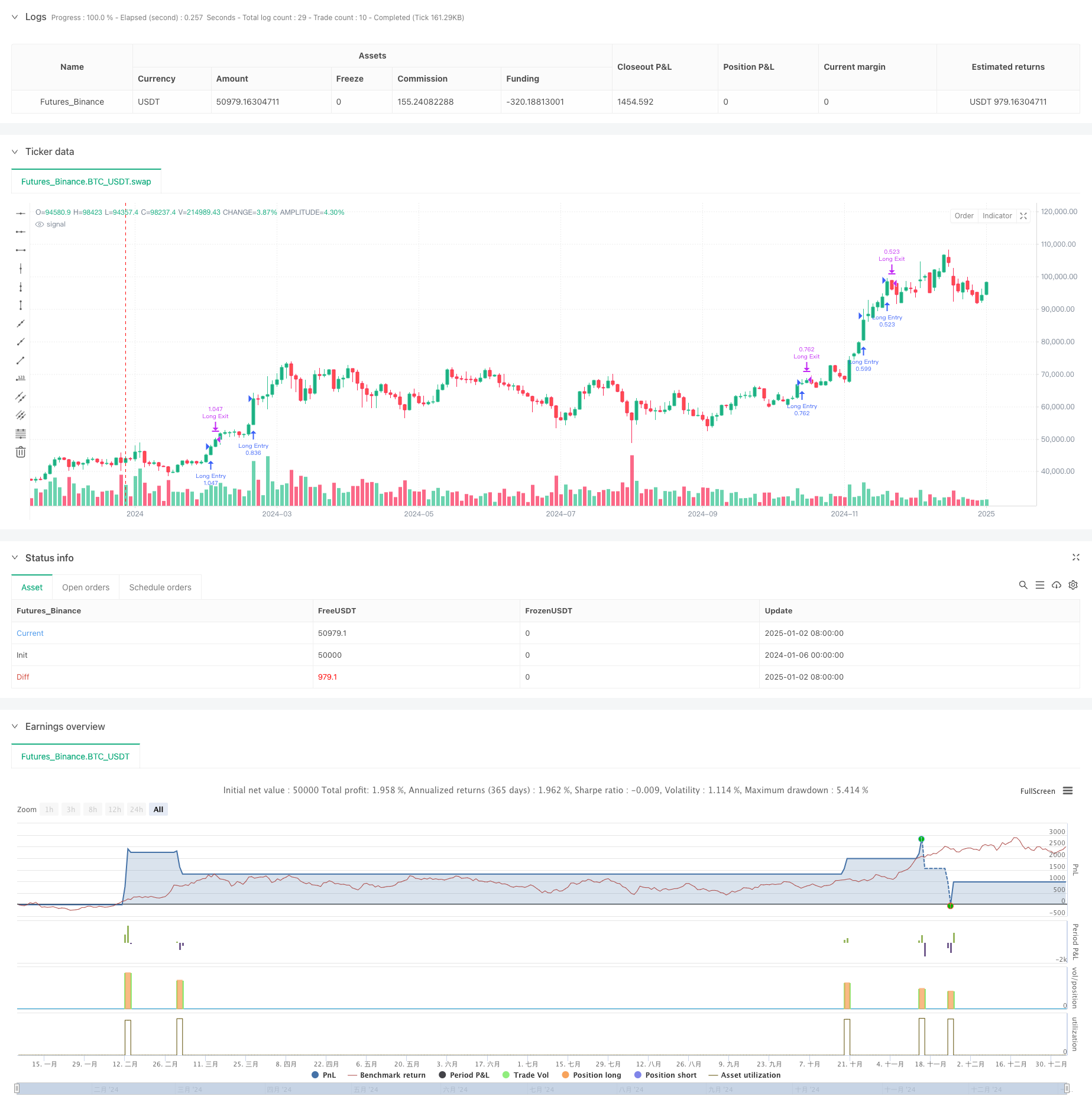
概述
该策略是一个结合了多重技术指标和ICT(机构交易概念)的综合性交易系统。它在不同时间周期上整合了传统技术分析指标(RSI、随机指标、MACD、EMA)与现代ICT交易理念(公允价值缺口、结构突破、高时间周期偏向性分析),并通过严格的交易时段过滤实现精准的市场准入控制。
策略原理
策略运作基于五个核心组件的协同: 1. 高时间周期偏向性分析:使用200均线判断更高时间周期的市场趋势方向 2. 交易时段过滤:限定在特定的”击杀区域”(07:00-10:00)内进行交易 3. 公允价值缺口(FVG)识别:通过三根K线模式识别市场结构性缺口 4. 结构突破(BOS)判定:基于关键价位的突破确认方向性变更 5. 低时间周期指标确认:利用RSI、随机指标、MACD和200均线的多重验证
策略优势
- 多维度信号整合:通过组合多个独立的技术指标和ICT概念,提高信号的可靠性
- 时间周期协同:高低时间周期的配合增强了信号的稳定性
- 结构性机会捕捉:通过FVG和BOS的识别,专注于高概率的结构性交易机会
- 风险控制完善:包含止损止盈机制,资金管理规范
- 交易时间优化:通过时段过滤降低了非交易时段的干扰
策略风险
- 信号滞后性:多重指标的综合可能导致入场时机延迟
- 震荡市场表现:在横盘市场中可能产生频繁的假信号
- 参数敏感性:多个指标参数的设置需要充分的历史数据验证
- 执行风险:复杂的条件组合可能在实盘中错过部分交易机会
- 市场环境依赖:策略在不同市场环境下的表现可能存在较大差异
策略优化方向
- 动态参数调整:根据市场波动率自适应调整各指标参数
- 市场环境分类:增加市场环境识别模块,针对不同市场状态采用不同的参数组合
- 信号权重优化:引入机器学习方法,优化各个指标的权重分配
- 时间周期扩展:增加更多时间周期的分析,提高信号的可靠性
- 风险控制增强:引入动态止损机制,优化资金管理策略
总结
该策略通过整合传统技术分析与现代ICT理念,构建了一个全面的交易系统。其优势在于多维度的信号确认和严格的风险控制,但也面临参数优化和市场适应性的挑战。通过持续优化和完善,策略有望在不同市场环境下保持稳定的表现。
策略源码
/*backtest
start: 2024-01-06 00:00:00
end: 2025-01-04 08:00:00
period: 2d
basePeriod: 2d
exchanges: [{"eid":"Futures_Binance","currency":"BTC_USDT"}]
*/
// -----------------------------------------------------
// Multi-Signal Conservative Strategy (Pine Script v5)
// + More ICT Concepts (HTF Bias, FVG, Killzone, BOS)
// -----------------------------------------------------
//
// Combines:
// - RSI, Stochastic, MACD, 200 EMA (lower TF)
// - Higher Timeframe (HTF) bias check via 200 EMA
// - Kill Zone time filter
// - Fair Value Gap (FVG) detection (simplified 3-candle approach)
// - Break of Structure (BOS) using pivot highs/lows
// - Only trade markers on chart (no extra indicator plots).
//
// Use on lower timeframes: 1m to 15m
// Always backtest thoroughly and manage risk properly.
//
// -----------------------------------------------------
//@version=5
strategy(title="Multi-Signal + ICT Concepts (HTF/FVG/Killzone/BOS)", shorttitle="ICTStrategyExample",overlay=true, pyramiding=0, initial_capital=10000, default_qty_type=strategy.percent_of_equity, default_qty_value=100)
// -----------------------------------------------------
// User Inputs
// -----------------------------------------------------
/////////////// Lower TF Inputs ///////////////
emaLength = input.int(200, "LTF EMA Length", group="Lower TF")
rsiLength = input.int(14, "RSI Length", group="Lower TF")
rsiUpper = input.int(60, "RSI Overbought Thresh", group="Lower TF", minval=50, maxval=80)
rsiLower = input.int(40, "RSI Oversold Thresh", group="Lower TF", minval=20, maxval=50)
stochLengthK = input.int(14, "Stoch K Length", group="Lower TF")
stochLengthD = input.int(3, "Stoch D Smoothing", group="Lower TF")
stochSmooth = input.int(3, "Stoch Smoothing", group="Lower TF")
macdFast = input.int(12, "MACD Fast Length", group="Lower TF")
macdSlow = input.int(26, "MACD Slow Length", group="Lower TF")
macdSignal = input.int(9, "MACD Signal Length", group="Lower TF")
/////////////// ICT Concepts Inputs ///////////////
htfTimeframe = input.timeframe("60", "HTF for Bias (e.g. 60, 240)", group="ICT Concepts")
htfEmaLen = input.int(200, "HTF EMA Length", group="ICT Concepts")
sessionInput = input("0700-1000:1234567", "Kill Zone Window", group="ICT Concepts")
fvgLookbackBars = input.int(2, "FVG Lookback Bars (3-candle check)", group="ICT Concepts", minval=1, maxval=10)
/////////////// Risk Management ///////////////
stopLossPerc = input.float(0.5, "Stop-Loss %", step=0.1, group="Risk")
takeProfitPerc = input.float(1.0, "Take-Profit %", step=0.1, group="Risk")
// -----------------------------------------------------
// 1) Higher Timeframe Bias
// -----------------------------------------------------
//
// We'll request the HTF close, then compute the HTF EMA on that data
// to decide if it's bullish or bearish overall.
htfClose = request.security(syminfo.tickerid, htfTimeframe, close)
htfEma = request.security(syminfo.tickerid, htfTimeframe, ta.ema(close, htfEmaLen))
isBullHTF = htfClose > htfEma
isBearHTF = htfClose < htfEma
// -----------------------------------------------------
// 2) Kill Zone / Session Filter
// -----------------------------------------------------
//
// We'll only consider trades if the current bar is within
// the user-defined session time (e.g., 07:00 to 10:00 local or exchange time).
isInKillZone = time(timeframe.period, sessionInput) != 0
// -----------------------------------------------------
// 3) Fair Value Gap (FVG) Detection (Simplified)
//
// For a "Bullish FVG" among bars [2], [1], [0]:
// high[2] < low[0] => there's a gap that bar [1] didn't fill
// For a "Bearish FVG":
// low[2] > high[0] => there's a gap that bar [1] didn't fill
//
// Real ICT usage might check partial fill, candle bodies vs wicks, etc.
// This is just a minimal example for demonstration.
fvgBarsAgo = fvgLookbackBars // default = 2
bullFVG = high[fvgBarsAgo] < low // e.g. high[2] < low[0]
bearFVG = low[fvgBarsAgo] > high // e.g. low[2] > high[0]
// -----------------------------------------------------
// 4) Break of Structure (BOS)
// -----------------------------------------------------
// Using pivot detection from previous example:
swingLen = 2 // pivot detection length (bars on each side)
// Identify a pivot high at bar [1]
swingHigh = high[1] > high[2] and high[1] > high[0]
// Identify a pivot low at bar [1]
swingLow = low[1] < low[2] and low[1] < low[0]
// Track the most recent pivot high & low
var float lastPivotHigh = na
var float lastPivotLow = na
if swingHigh
lastPivotHigh := high[1]
if swingLow
lastPivotLow := low[1]
bosUp = not na(lastPivotHigh) and (close > lastPivotHigh)
bosDown = not na(lastPivotLow) and (close < lastPivotLow)
// -----------------------------------------------------
// 5) Lower TF Indicator Calculations
// -----------------------------------------------------
ema200 = ta.ema(close, emaLength) // 200 EMA on LTF
rsiValue = ta.rsi(close, rsiLength)
kValue = ta.stoch(high, low, close, stochLengthK)
dValue = ta.sma(kValue, stochLengthD)
stochSignal = ta.sma(dValue, stochSmooth)
[macdLine, signalLine, histLine] = ta.macd(close, macdFast, macdSlow, macdSignal)
// LTF trend filter
isBullTrend = close > ema200
isBearTrend = close < ema200
// -----------------------------------------------------
// Combine All Conditions
// -----------------------------------------------------
//
// We'll require that all filters line up for a long or short:
// - HTF bias
// - kill zone
// - bullish/bearish FVG
// - BOS up/down
// - RSI, Stoch, MACD alignment
// - Price above/below LTF 200 EMA
longCondition = isInKillZone // must be in session
and isBullHTF // HTF bias bullish
and bullFVG // bullish FVG
and bosUp // BOS up
and (rsiValue > rsiUpper) // RSI > threshold
and (kValue > dValue) // stoch K above D
and (macdLine > signalLine) // MACD bullish
and isBullTrend // above LTF 200 EMA
shortCondition = isInKillZone // must be in session
and isBearHTF // HTF bias bearish
and bearFVG // bearish FVG
and bosDown // BOS down
and (rsiValue < rsiLower) // RSI < threshold
and (kValue < dValue) // stoch K below D
and (macdLine < signalLine) // MACD bearish
and isBearTrend // below LTF 200 EMA
// -----------------------------------------------------
// Strategy Entries
// -----------------------------------------------------
if longCondition
strategy.entry("Long Entry", strategy.long)
if shortCondition
strategy.entry("Short Entry", strategy.short)
// -----------------------------------------------------
// Risk Management (Stop-Loss & Take-Profit)
// -----------------------------------------------------
if strategy.position_size > 0
// Long position exit
strategy.exit("Long Exit", stop = strategy.position_avg_price * (1.0 - stopLossPerc/100.0), limit = strategy.position_avg_price * (1.0 + takeProfitPerc/100.0))
if strategy.position_size < 0
// Short position exit
strategy.exit("Short Exit", stop = strategy.position_avg_price * (1.0 + stopLossPerc/100.0), limit = strategy.position_avg_price * (1.0 - takeProfitPerc/100.0))
// -----------------------------------------------------
// Hide All Indicator Plots
// (We only show trade markers for entry & exit)
// -----------------------------------------------------
// Comment out or remove any plot() calls so chart stays clean.
//
// Example (commented out):
// plot(ema200, title="EMA 200", color=color.new(color.yellow, 0), linewidth=2)
// plot(rsiValue, title="RSI", color=color.new(color.blue, 0))
// plot(macdLine, title="MACD", color=color.new(color.teal, 0))
// plot(signalLine, title="Signal", color=color.new(color.purple, 0))
相关推荐